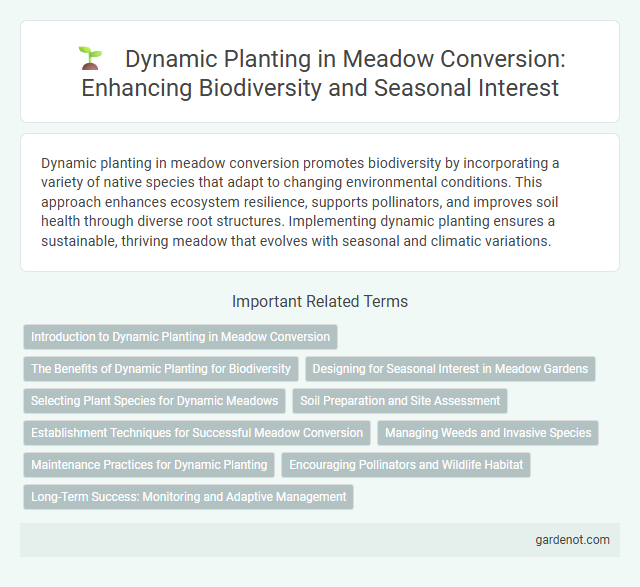Dynamic planting in meadow conversion promotes biodiversity by incorporating a variety of native species that adapt to changing environmental conditions. This approach enhances ecosystem resilience, supports pollinators, and improves soil health through diverse root structures. Implementing dynamic planting ensures a sustainable, thriving meadow that evolves with seasonal and climatic variations.
Introduction to Dynamic Planting in Meadow Conversion
Dynamic planting in meadow conversion involves strategically selecting and sequencing native plant species to enhance biodiversity and ecosystem resilience. This approach adapts to seasonal growth patterns and soil conditions, promoting a self-sustaining habitat that supports pollinators and wildlife. Integrating dynamic planting accelerates meadow establishment and improves long-term ecological balance.
The Benefits of Dynamic Planting for Biodiversity
Dynamic planting enhances biodiversity by introducing a variety of native plant species that adapt to seasonal and environmental changes, fostering diverse habitats for pollinators, birds, and other wildlife. This approach promotes ecosystem resilience, improves soil health, and supports natural pest control through varied vegetation structures. By mimicking natural succession processes, dynamic planting creates a sustainable, multi-layered meadow ecosystem that maximizes biological diversity and ecological stability.
Designing for Seasonal Interest in Meadow Gardens
Dynamic planting in meadow conversion emphasizes selecting diverse native species that bloom sequentially to ensure continuous visual interest throughout the seasons. Incorporating early-blooming wildflowers, mid-season grasses, and late-flowering perennials creates a vibrant, evolving landscape that supports pollinators year-round. Designing for seasonal interest enhances biodiversity, promotes ecological balance, and transforms meadow gardens into living canvases that change color and texture from spring through autumn.
Selecting Plant Species for Dynamic Meadows
Selecting plant species for dynamic meadows involves prioritizing native, drought-tolerant varieties that support local biodiversity and adapt well to soil conditions. Incorporating a mix of flowering perennials, grasses, and legumes ensures seasonal interest and resilience against pests and diseases. Dynamic planting strategies emphasize species diversity to enhance ecosystem services such as pollination, carbon sequestration, and soil health.
Soil Preparation and Site Assessment
Dynamic planting in meadow conversion hinges on meticulous soil preparation and comprehensive site assessment. Soil testing identifies nutrient levels and pH balance, guiding amendments that optimize seed germination and root development. Thorough site evaluation ensures selection of native species suited to local microclimates, promoting biodiversity and sustainable meadow establishment.
Establishment Techniques for Successful Meadow Conversion
Dynamic planting optimizes establishment techniques by selecting native grasses and wildflowers that are well-adapted to local soil and climate conditions, enhancing survival rates. Using seed mixes with varying maturation times promotes continuous bloom and supports biodiversity throughout the growing season. Proper soil preparation, such as minimal tilling and soil nutrient assessment, ensures optimal root development and reduces competition from invasive species during meadow conversion.
Managing Weeds and Invasive Species
Dynamic planting in meadow conversion involves strategic selection and timing to suppress weeds and invasive species naturally. Implementing diverse native plant mixes enhances competitive growth, reducing the establishment of unwanted plants and promoting ecosystem balance. Regular monitoring and adaptive management ensure invasive species are controlled early, maintaining meadow health and biodiversity.
Maintenance Practices for Dynamic Planting
Dynamic planting maintenance practices for meadow conversion emphasize adaptive management techniques to support plant diversity and soil health. Regular monitoring of species composition guides selective mowing and targeted weeding, preventing dominance of aggressive plants and encouraging native flora establishment. Incorporating seasonal adjustments and minimal intervention practices helps maintain ecosystem resilience and promotes long-term sustainability of dynamic meadows.
Encouraging Pollinators and Wildlife Habitat
Dynamic planting in meadow conversion enhances biodiversity by integrating native flowering plants that provide essential nectar and pollen sources for pollinators such as bees, butterflies, and hoverflies. This approach creates a multi-layered habitat structure, supporting a wide range of wildlife including birds, small mammals, and beneficial insects. By promoting seasonal bloom succession, dynamic planting sustains continuous food availability and shelter, fostering resilient ecosystems and ecological balance.
Long-Term Success: Monitoring and Adaptive Management
Dynamic planting techniques enhance long-term success in meadow conversion by promoting species diversity and ecosystem resilience. Continuous monitoring of plant growth, soil conditions, and wildlife activity enables timely adjustments to planting strategies and resource allocation. Adaptive management based on ecological feedback ensures sustainable habitat development and supports restoration goals over time.
Dynamic planting Infographic

 gardenot.com
gardenot.com